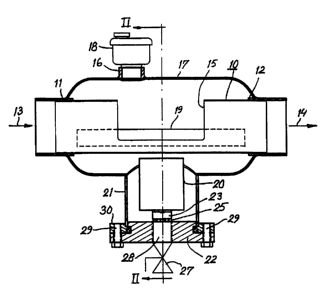Une partie des informations de ce site Web a été fournie par des sources externes. Le gouvernement du Canada n'assume aucune responsabilité concernant la précision, l'actualité ou la fiabilité des informations fournies par les sources externes. Les utilisateurs qui désirent employer cette information devraient consulter directement la source des informations. Le contenu fourni par les sources externes n'est pas assujetti aux exigences sur les langues officielles, la protection des renseignements personnels et l'accessibilité.
L'apparition de différences dans le texte et l'image des Revendications et de l'Abrégé dépend du moment auquel le document est publié. Les textes des Revendications et de l'Abrégé sont affichés :
| (12) Brevet: | (11) CA 2313237 |
|---|---|
| (54) Titre français: | DISPOSITIF DE TRAITEMENT DE L'EAU COMPRENANT UN MODULE DE PROTECTION CONTRE LA CORROSION |
| (54) Titre anglais: | CORROSION PROTECTED WATER TREATMENT DEVICE |
| Statut: | Réputé périmé |
| (51) Classification internationale des brevets (CIB): |
|
|---|---|
| (72) Inventeurs : |
|
| (73) Titulaires : |
|
| (71) Demandeurs : |
|
| (74) Agent: | NA |
| (74) Co-agent: | NA |
| (45) Délivré: | 2007-02-06 |
| (86) Date de dépôt PCT: | 1998-12-08 |
| (87) Mise à la disponibilité du public: | 1999-07-08 |
| Requête d'examen: | 2003-11-21 |
| Licence disponible: | S.O. |
| (25) Langue des documents déposés: | Anglais |
| Traité de coopération en matière de brevets (PCT): | Oui |
|---|---|
| (86) Numéro de la demande PCT: | PCT/SE1998/002240 |
| (87) Numéro de publication internationale PCT: | WO1999/034032 |
| (85) Entrée nationale: | 2000-06-07 |
| (30) Données de priorité de la demande: | ||||||
|---|---|---|---|---|---|---|
|
Ce dispositif, qui sert à traiter l'eau circulant dans un système de conduits fermé, comprend en association un dégazeur, d'une part, et un inhibiteur de corrosion, d'autre part. Le dégazeur comporte un élément tubulaire (10) qui est horizontal dans sa position d'utilisation et qui est conçu pour être raccordé en série à un conduit (13,14) faisant partie dudit système de conduits. L'élément tubulaire est entouré entre ses extrémités amont et aval (11, 12) par un logement (17) qui est pourvu d'un orifice de sortie de gaz supérieur (16) pouvant s'ouvrir. L'élément tubulaire communique avec l'espace environnant du logement par l'intermédiaire d'au moins une ouverture (15) ménagée dans ledit élément tubulaire. L'inhibiteur de corrosion est pourvu d'une anode sacrificielle (20) qui est située dans l'espace du logement extérieur à l'élément tubulaire (10). Le logement (17) comprend également un drain ou un orifice de sortie inférieur (28) pouvant s'ouvrir.
A device for treating water that
circulates in a closed conduit system,
said device comprising a combination
of a degasifier, on the one hand, and a
corrosion inhibitor, on the other hand.
The degasifier includes a tubular
member (10) which is horizontal in its use
position and which is intended to be
connected in series with a conduit (13,
14) forming part of the conduit system.
The tubular member is surrounded
between its upstream and downstream
ends (11, 12) by a housing (17) which
includes an openable upper gas outlet
(16). The tubular member
communicates with the surrounding housing
space through the medium of at least
one aperture (15) provided therein.
The corrosion inhibitor includes a
sacrificial anode (20) which is positioned
in the housing space outside the tubular
member (10). The housing (17)
also includes an openable bottom drain
or outlet (28).
Note : Les revendications sont présentées dans la langue officielle dans laquelle elles ont été soumises.
Note : Les descriptions sont présentées dans la langue officielle dans laquelle elles ont été soumises.

Pour une meilleure compréhension de l'état de la demande ou brevet qui figure sur cette page, la rubrique Mise en garde , et les descriptions de Brevet , États administratifs , Taxes périodiques et Historique des paiements devraient être consultées.
| Titre | Date |
|---|---|
| Date de délivrance prévu | 2007-02-06 |
| (86) Date de dépôt PCT | 1998-12-08 |
| (87) Date de publication PCT | 1999-07-08 |
| (85) Entrée nationale | 2000-06-07 |
| Requête d'examen | 2003-11-21 |
| (45) Délivré | 2007-02-06 |
| Réputé périmé | 2010-12-08 |
Il n'y a pas d'historique d'abandonnement
| Type de taxes | Anniversaire | Échéance | Montant payé | Date payée |
|---|---|---|---|---|
| Enregistrement de documents | 100,00 $ | 2000-06-07 | ||
| Le dépôt d'une demande de brevet | 150,00 $ | 2000-06-07 | ||
| Taxe de maintien en état - Demande - nouvelle loi | 2 | 2000-12-08 | 100,00 $ | 2000-12-04 |
| Taxe de maintien en état - Demande - nouvelle loi | 3 | 2001-12-10 | 100,00 $ | 2001-11-23 |
| Taxe de maintien en état - Demande - nouvelle loi | 4 | 2002-12-09 | 100,00 $ | 2002-11-18 |
| Taxe de maintien en état - Demande - nouvelle loi | 5 | 2003-12-08 | 150,00 $ | 2003-11-17 |
| Requête d'examen | 400,00 $ | 2003-11-21 | ||
| Taxe de maintien en état - Demande - nouvelle loi | 6 | 2004-12-08 | 200,00 $ | 2004-11-18 |
| Taxe de maintien en état - Demande - nouvelle loi | 7 | 2005-12-08 | 200,00 $ | 2005-11-22 |
| Taxe finale | 300,00 $ | 2006-08-15 | ||
| Taxe de maintien en état - Demande - nouvelle loi | 8 | 2006-12-08 | 200,00 $ | 2006-11-21 |
| Taxe de maintien en état - brevet - nouvelle loi | 9 | 2007-12-10 | 200,00 $ | 2007-11-23 |
| Taxe de maintien en état - brevet - nouvelle loi | 10 | 2008-12-08 | 250,00 $ | 2008-11-20 |
Les titulaires actuels et antérieures au dossier sont affichés en ordre alphabétique.
| Titulaires actuels au dossier |
|---|
| AVONNI AB |
| Titulaires antérieures au dossier |
|---|
| PERSSON, LEIF |